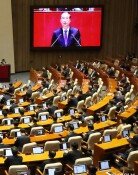Student Medical Check-Ups Lacking
The Student Medical Examination System, adopted for the first time this year to monitor the medical state of primary and secondary school students, has turned out to be nominal.
According to materials obtained from sources including the Ministry of Education and Human Resources Development by National Grand Party Assemblyman Lee Ju-ho, a member of the National Assembly Education Committee, only 450,000 (17.5 percent) of the 2,567,000 students subject to the new policy have taken medical examinations as of September 2006.
The new system was made effective by revising the School Health Law following indications that the physical check-ups by individual schools were only formalities, leaving students health supervision neglected. According to the new system, all primary and secondary students across the country must take a comprehensive check-up at a nearby medical examination facility every three years. This year, first and fourth year students in elementary schools, and first year students in middle schools and high schools are due to receive check-ups.
Assemblyman Lee analyzed the reasons for the current neglect of student medical examinations to be the unwillingness of medical institutions to give student check-ups, which are lower-priced (9,000 12,000 won per student) than general check-ups, and the lack of supervision regarding whether students actually go in to get the check-ups.
Assemblyman Lee said, Measures such as having the medical institutions come out to schools for most of the examinations and supporting the examination payments of low-income students are being called for.
He also added that in order to assure substantiality of student examinations, current mental health issues such as teenage game addiction, depression, and attention-deficit disorder (ADD) should be added to the examination items.
Meanwhile, 57.5 percent (258,000) of the students who took medical examinations this year had oral diseases and 46 percent (207,000) disorders regarding their eyes. Nasal (6.2 percent), urinal (5.8 percent), and dermatological (4.8 percent) disorder rates were high as well.
It was also pointed out that systematic health education for the purpose of helping students take care of their health is not being adequately provided.
Lee said, Only 45 percent of the target student group for this year has received health education. Systematic health education for students is urgently needed.
myzodan@donga.com







